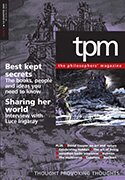The Aesthetic Unconscious by Jacques Rancière (Polity) £9.99/$12.95 (pb)

Apparition of a Face and Fruit Dish on a Beach, Salvador Dalí
Freud’s reliance on literature and myth has led many philosophers to dismiss his work as merely a new modern mythology. This charge was originally made by Wittgenstein, who also acerbically remarked that although Freud gave dreams a sexual interpretation he never mentioned dreams that were actually about sex which are “as common as rain”. If philosophers have used Freud’s reliance on literature as a stick to beat psychoanalysis with, writers and artists have been hardly more welcoming. Despite drawing heavily on Freudian ideas, so much so that applying psychoanalysis to literature and art post-Freud is often like shooting fish in a barrel, they have also chafed against any attempt to reduce their works to the expression of childhood sexual desires.
This short book by the contemporary French philosopher Jacques Rancière, originally presented as two lectures in 2000, aims to take a step back from the acrimonious debates occasioned by Freud’s writing on art and literature. What Rancière wants to explain is why literary references play such a crucial role in Freud’s work. He argues that the reason Freud found such fecund material in art and literature is that they are already a place where the unconscious is at work. This does not mean that Freud was right and the poets were honoured forerunners of psychoanalysis. Instead Rancière, in this unfortunately brief sketch, suggests a more radical thesis: psychoanalysis does not find its allies in art and literature but rather tries to colonise a previously-existing “aesthetic unconscious” with the “Freudian unconscious”.
In a dense argument Rancière suggests that aesthetics is not simply a new discipline of philosophy dedicated to art, but rather names a revolution in how we think. He argues that, beginning with Kant, and then solidified by Hegel and Schiller, aesthetics is a revolutionary new regime for thinking in which we are forced to accept the savagery and pathos of thought. Overturning the ordered thinking of classical art, this aesthetic revolution gives birth to a new aesthetic unconscious, in which philosophy is constantly confronting the infernal powers unleashed within thought. According to Rancière this coming to terms with “non-thought” takes two forms: the first is the attempt to draw these dark powers back within reason by giving them a meaning, although the result is often the elaboration of strange new mythologies as reason itself becomes permeated by the irrational. This is the path taken by psychoanalysis, which draws every insignificant detail, such as the famous Freudian slips, into meaning. The second form takes the reverse direction, moving from the meaningful world down into the meaninglessness of existence and the mute suffering of the body. Exemplified by Schopenhauer, this leads to us plunging down into the unconscious; as Joseph Conrad said, “in the destructive element immerse”.
The result is that the psychoanalytic unconscious tries to occupy the ground opened up by the aesthetic revolution. This does not simply mean that Freud derives his work from art and literature because he tries to bring order to this disorder, especially trying to combat the nihilistic entropy of the descent into the infernal depths of the unconscious. Rancière argues that to achieve this Freud plays off a classical approach to art – and Freud’s taste in art was notably traditional and conservative – against the more “modern” taste for the fantastic. Surprisingly, Rancière does not mention that this was staged in the comic misunderstandings of Freud’s meetings with the surrealists. Happy to have admirers, Freud was perplexed by these aesthetic radicals, and would later comment that he thought they were “complete fools” (although he made an exception for Dali’s technical mastery). While the surrealists tried to render reality fantastic (as “surreality”, or super-reality), Freud was more concerned with the stoic or tragic task of treating the unconscious rationally, and policing the boundary between fantasy and reality.
Rancière’s little book offers, rather ironically, its own compelling and coherent story of Freud’s reliance on art. Certainly, the work is hedged around with cautionary notes, as Rancière insists he is not trying to derive psychoanalysis from the aesthetic unconscious and admits his lack of competence in psychoanalysis. Of course psychoanalysis has taught us to be suspicious of denials, false modesty, and neat narratives. It is difficult not to suppose that Freud is being explained in terms of the aesthetic, and hard not to suspect that Rancière reduces some of the complex currents that run through Freud’s work. That said, Rancière offers a fascinating new optic through which to read psychoanalysis, and his original positioning of Freud in relation to art and literature is valuable in a field where partisan defences and blanket dismissals tend to hold sway.
Benjamin Noys is reader in English at Chichester University
Read all tpm’s reviews as soon as they are published, and much more, by subscribing to the magazine
 Email This Post
Email This Post 



Let’s not take the unconscious for granted though. If, as many suggest (Witt for one), the unconscious is a password to get into new mythical domains and persuasions, then we might ask what Freud was really up to or what we actually mean when we say things like “Freud was more concerned with the stoic or tragic task of treating the unconscious rationally”.
[...] Noys’ review in TPM of Rancière’s The Aesthetic Unconscious (London: Polity, 2011). Also, Adam [...]